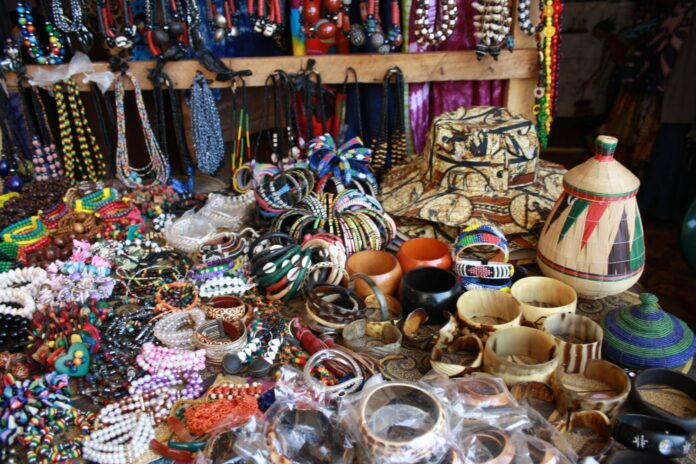By Michaella Faith Wright
In the bustling markets of The Gambia, the vibrant colours and intricate designs of traditional crafts are experiencing a renaissance. As modern influences permeate every aspect of life, the preservation and revival of these age-old arts are crucial in maintaining the rich cultural heritage of the nation. This revival is not only a testament to the resilience of Gambian culture but also a significant contributor to the local economy and community identity.
The Heartbeat of Culture
Traditional crafts in The Gambia, such as weaving, pottery, and beadwork, are more than just art forms — they are the heartbeat of the nation’s cultural legacy. Each piece tells a story of the people, their history, and their way of life. However, with the advent of globalization and modern technology, these traditions have faced the threat of fading into obscurity.
From the intricate beadwork that adorns traditional clothing to the masterful weaving that creates vibrant textiles, these crafts are embedded in the everyday life and celebrations of the Gambian people. The rhythmic beat of the kora, a traditional West African stringed instrument, often accompanies artisans at work, creating an atmosphere where the past and present intertwine.
Empowering Artisans
At the forefront of this cultural revival are the artisans themselves. Individuals like Awa Sanyang, a master weaver from the village of Brikama, have dedicated their lives to preserving these traditions. “Weaving is not just a skill; it is a connection to my ancestors,” Awa shares. “Through my work, I keep their memories and their wisdom alive.”
Organizations and initiatives have sprung up to support artisans like Awa. The Gambia Craft and Cultural Promotion Center (GCCPC) provides training, resources, and platforms for artisans to showcase their work. By empowering these craftsmen and women, the centre ensures that traditional skills are not only preserved but also adapted to contemporary markets. Artisans receive education in business management and digital marketing, enabling them to reach a wider audience and secure better income for their families.
Economic and Social Impact
The resurgence of traditional crafts has had a profound impact on local communities. Artisans now have the opportunity to earn a sustainable income, improving their quality of life and that of their families. Additionally, the craft industry attracts tourists eager to purchase authentic, handmade souvenirs, further boosting the local economy.
For Fatoumata Touray, a potter from Banjul, the revival has been life-changing.
“Through my pottery, I can provide for my children and send them to school,” she explains, adding: “It gives me pride to see my work appreciated by people from around the world.”
The economic benefits extend beyond individual artisans, fostering a sense of community pride and resilience.
Preserving Identity Amid Modernization
In a rapidly modernizing world, maintaining a sense of cultural identity is vital. Traditional crafts offer a tangible link to the past, grounding communities in their heritage. This connection fosters a sense of pride and continuity, particularly among the younger generation.
Educational programs have been introduced to teach children the importance of these crafts. Schools now incorporate craft workshops into their curricula, allowing students to learn and appreciate the skills of their ancestors. By engaging the youth, these programs ensure that the crafts will continue to thrive for generations to come. In communities across The Gambia, young people gather after school to learn from master artisans, creating a vibrant intergenerational dialogue.
Challenges and the Way Forward
Despite the positive strides, challenges remain. The lack of access to quality materials, competition from mass-produced goods, and limited market reach are significant hurdles for many artisans. However, with continued support from governmental and non-governmental organizations, there is hope for overcoming these obstacles.
Digital platforms and social media are emerging as powerful tools for artisans to market their work globally. Online marketplaces and virtual craft fairs offer new avenues for sales, expanding the reach of Gambian crafts beyond national borders. Initiatives such as “Crafts of The Gambia” provide artisans with the tools and training to create compelling online presences, helping them to tell their stories and connect with customers worldwide.
Conclusion
The revival of traditional crafts in The Gambia is a testament to the enduring spirit of its people. As these crafts flourish, they not only preserve the cultural heritage of the nation but also empower communities and contribute to economic development. By valuing and supporting these ancient arts, The Gambia is ensuring that its rich history and vibrant culture continue to shine brightly in the modern world.
In the words of master weaver Awa Sanyang, “When we create, we do more than make art; we weave the threads of our culture into the fabric of our future.”
As The Gambia continues to embrace both its past and its future, the revival of traditional crafts stands as a beacon of resilience, pride, and cultural preservation. Through collective efforts, the country is ensuring that the stories, skills, and heritage of its people are not only remembered but celebrated and sustained for generations to come.




